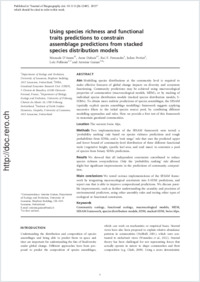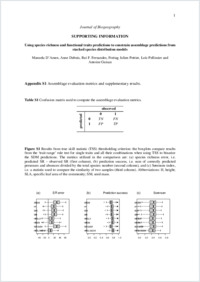Using species richness and functional traits predictions to constrain assemblage predictions from stacked species distribution models
- D'Amen, Manuela Department of Ecology and Evolution, University of Lausanne, Switzerland
- Dubuis, Anne Department of Ecology and Evolution, University of Lausanne, Switzerland
- Fernandes, Rui F. Department of Ecology and Evolution, University of Lausanne, Switzerland
- Pottier, Julien INRA, Grassland Ecosystem Research Unit (UREP), Clermont-Ferrand, France
- Pellissier, Loïc Department of Ecology and Evolution, University of Lausanne, Switzerland - Department of Biology, Ecology and Evolution, University of Fribourg, Switzerland
- Guisan, Antoine Department of Ecology and Evolution, University of Lausanne, Switzerland - Institute of Earth Surface Dynamics, Geopolis, University of Lausanne, Switzerland
-
01.02.2015
Published in:
- Journal of Biogeography. - 2015, p. –
English
Aim: Modelling species distributions at the community level is required to make effective forecasts of global change impacts on diversity and ecosystem functioning. Community predictions may be achieved using macroecological properties of communities (macroecological models, MEM), or by stacking of individual species distribution models (stacked species distribution models, S-SDMs). To obtain more realistic predictions of species assemblages, the SESAM (spatially explicit species assemblage modelling) framework suggests applying successive filters to the initial species source pool, by combining different modelling approaches and rules. Here we provide a first test of this framework in mountain grassland communities.Location: The western Swiss Alps.Methods: Two implementations of the SESAM framework were tested: a ‘probability ranking’ rule based on species richness predictions and rough probabilities from SDMs, and a ‘trait range’ rule that uses the predicted upper and lower bound of community-level distribution of three different functional traits (vegetative height, specific leaf area, and seed mass) to constrain a pool of species from binary SDMs predictions.Results: We showed that all independent constraints contributed to reduce species richness overprediction. Only the ‘probability ranking’ rule allowed slight but significant improvements in the predictions of community composition.Main conclusions: We tested various implementations of the SESAM framework by integrating macroecological constraints into S-SDM predictions, and report one that is able to improve compositional predictions. We discuss possible improvements, such as further understanding the causality and precision of environmental predictors, using other assembly rules and testing other types of ecological or functional constraints.
- Faculty
- Faculté des sciences et de médecine
- Department
- Département de Biologie
- Language
-
- English
- Classification
- Ecology and biodeversity
- License
- License undefined
- Identifiers
-
- RERO DOC 235561
- DOI 10.1111/jbi.12485
- Persistent URL
- https://folia.unifr.ch/unifr/documents/304201
Other files
Statistics
Document views: 61
File downloads:
- pel_usr.pdf: 417
- pel_usr_sm.pdf: 90

